The General (1926 film)
9.2 /10 1 Votes
93% Rotten Tomatoes Duration | 8.3/10 IMDb 4/4 Roger Ebert Genre Action, Adventure, Comedy Country United States | |||||||||||||||||||||||||||||||||
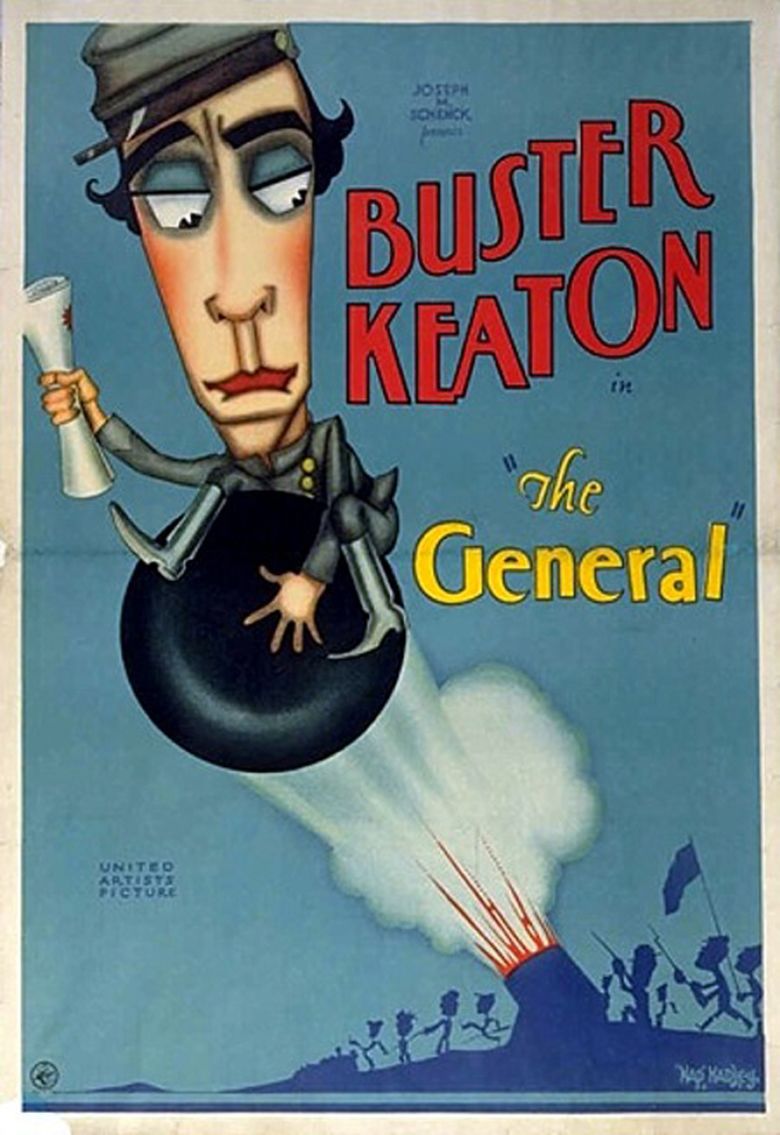 | ||||||||||||||||||||||||||||||||||
Language Silent filmEnglish intertitles Director Clyde BruckmanBuster Keaton Release date December 31, 1926 (1926-12-31) Screenplay Buster Keaton, Clyde Bruckman, Paul Girard Smith Cast Buster Keaton (Johnny Gray), (Annabelle Lee), (Captain Anderson), Jim Farley (General Thatcher), (A Southern General), Charles Henry Smith (Annabelle's Father (as Charles Smith))Similar movies Back to the Future Part III , Starship Troopers , Dawn of the Dead , Akira , Lovers , The Birth of a Nation | ||||||||||||||||||||||||||||||||||
The General is a 1926 American silent comedy film released by United Artists. It was inspired by the Great Locomotive Chase, a true story of an event that occurred during the American Civil War. The story was adapted from the memoir The Great Locomotive Chase by William Pittenger. The film stars Buster Keaton who co-directed it with Clyde Bruckman.
Contents
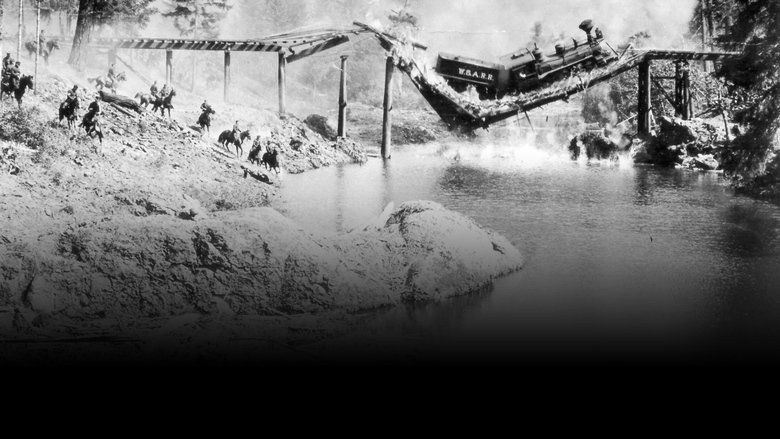
At the time of its initial release, The General, an action-adventure-comedy made toward the end of the silent era, was not well received by critics and audiences, resulting in mediocre box office returns (about half a million dollars domestically, and approximately one million worldwide). Because of its then-huge budget ($750,000 supplied by Metro chief Joseph Schenck) and failure to turn a significant profit, Keaton lost his independence as a filmmaker and was forced into a restrictive deal with MGM. In 1954 the film entered the public domain (in the USA), owing to the claimant's failure to renew its copyright registration in the 28th year after publication.

The General has since been reevaluated, and is now often ranked among the greatest American films ever made.
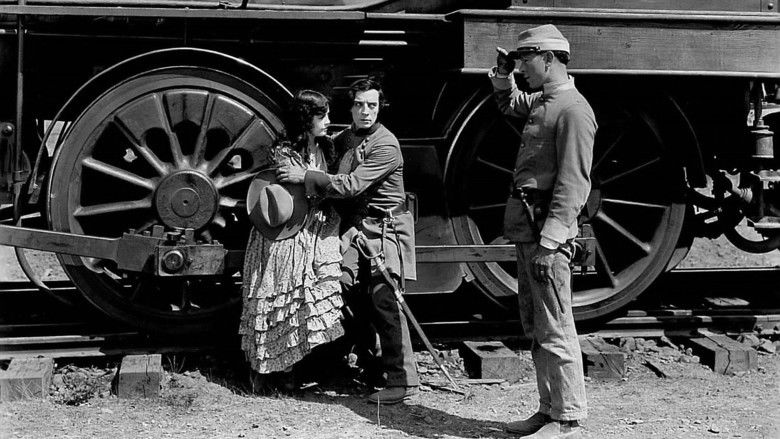
Plot

Western & Atlantic Railroad train engineer Johnnie Gray (Keaton) is in Marietta, Georgia to see one of the two loves of his life, his fiancée Annabelle Lee (Marion Mack)—the other being his locomotive, The General—when the American Civil War breaks out. He hurries to be first in line to enlist in the Confederate Army, but is rejected because he is too valuable in his present job; unfortunately, Johnnie is not told this reason and is forcibly ejected. On leaving, he runs into Annabelle's father and brother, who beckon to him to join them in line, but he sadly walks away, giving them the impression that he does not want to enlist. Annabelle coldly informs Johnnie that she will not speak to him again until he is in uniform.

A year passes, and Annabelle receives word that her father has been wounded. She travels north on The General to see him but still wants nothing to do with Johnnie. When the train makes a stop, the passengers detrain for a quick meal. As planned, Union spies led by Captain Anderson (Glen Cavender) use the opportunity to steal the train. Annabelle becomes an inadvertent prisoner. Johnnie gives chase, first on foot, then by handcar and boneshaker bicycle, before reaching a station in Chattanooga. He alerts the army detachment there, which boards another train to give chase, with Johnnie manning the locomotive, the Texas. However, the flatcars are not hooked up to the engine, and the troops are left behind. By the time Johnnie realizes he is alone, it is too late to turn back.
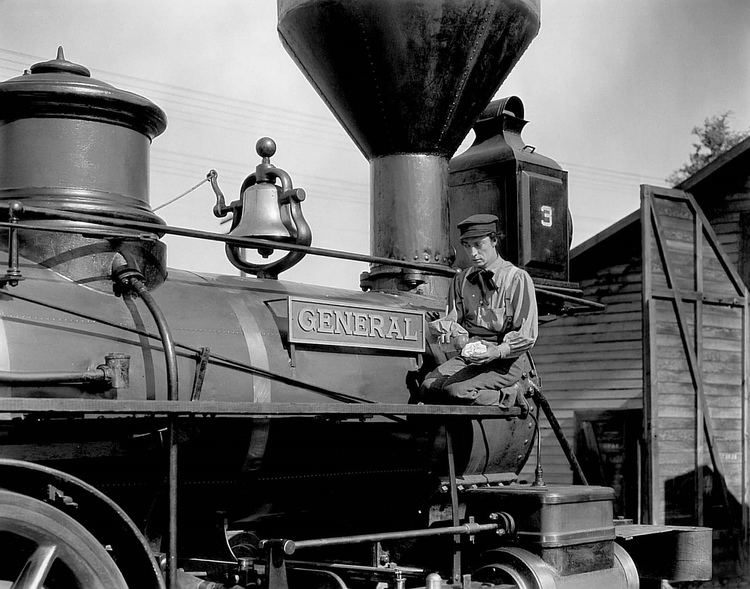
The Union agents try a variety of methods to shake their dogged pursuer (convinced he is accompanied by Confederate soldiers), including disconnecting their trailing car and dropping railroad ties on the tracks. As the unusual duel continues northward, the Confederate Army of Tennessee is ordered to retreat and the Northern army advances in its wake. Johnnie finally notices he is surrounded by Union soldiers and the hijackers see that Johnnie is by himself. Johnnie stops his locomotive and runs into the forest to hide.
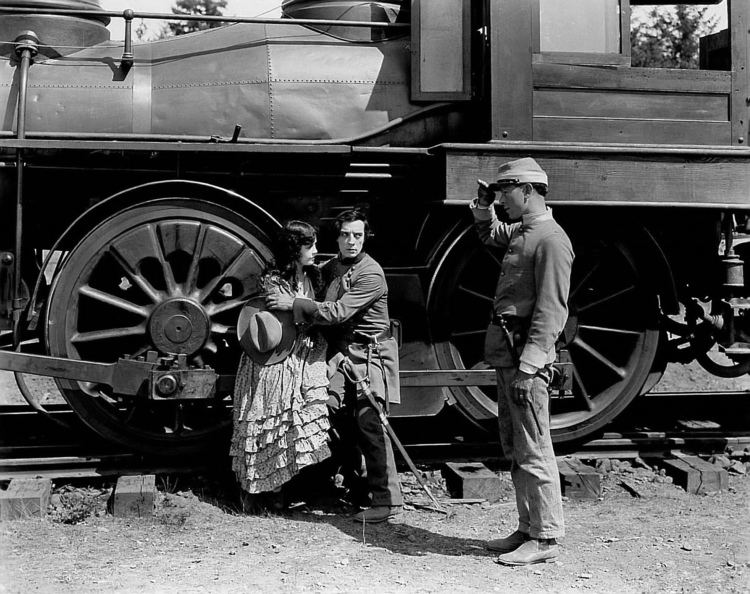
At nightfall, Johnnie stumbles upon the Northern encampment. Hungry, he climbs through a window to steal some food, but hides underneath the table when some officers enter. He overhears their plan for a surprise attack and that the Rock River Bridge is essential for their supply trains. He then sees Annabelle brought in; she is taken to a room under guard while they decide what to do with her. Johnnie manages to knock out both guards and free Annabelle. They escape into the woods.
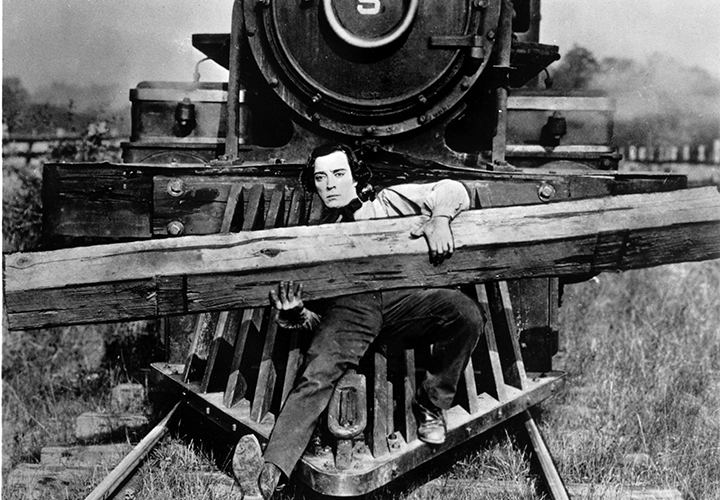
The next day, Johnnie and Annabelle find themselves near a railway station, where Union soldiers and equipment are being organized for the attack. Seeing The General, Johnnie devises a plan to warn the South. After sneaking Annabelle onto a boxcar behind The General, Johnnie steals his engine back. Two Union trains, including the Texas, set out after the pair, while the Union attack is immediately launched. In a reversal of the first chase, Johnnie has to fend off his pursuers. Finally, he starts a fire behind The General in the center of the Rock River Bridge.
Reaching friendly lines, Johnnie warns the local army commander of the impending attack. Confederate forces rush to defend the bridge. Meanwhile, Annabelle is reunited with her convalescing father. The Texas drives onto the burning bridge, which collapses (in what would later come to be recognized as the most expensive stunt of the silent era). Union soldiers try to ford the river, but Confederate fire drives them back.
Afterward, Johnnie returns to his locomotive to find the Union officer whom he had knocked out earlier, in order to escape, regaining consciousness. He takes the officer captive and is spotted by the general leaving the locomotive with his prisoner. As a reward for his bravery, he is commissioned a lieutenant and given the captured officer's sword. He tries to kiss Annabelle but has to return the salutes of soldiers. Johnnie finally uses one hand to embrace his girlfriend while using his other to blindly salute
Cast
Production
In early 1926, Keaton's collaborator Clyde Bruckman told him about William Pittenger's 1863 memoir The Great Locomotive Chase, about the 1862 Great Locomotive Chase. Keaton was a huge fan of train history and read the book. Although it was written from the Union Army perspective, Keaton did not believe that the audience would accept Confederates as villains and changed the story's point of view. Keaton attempted to rent the real-life General for the film. At that time, the train was on display at a Chattanooga, Tennessee rail station, but the train's owners denied Keaton's request when they realized that the film was going to be a comedy.
In April 1926, Keaton's location manager, Burt Jackson, found an area in central Oregon with old-fashioned railroads which was a perfect setting for the film. He also discovered that the Oregon, Pacific and Eastern Railway owned two vintage trains from the Civil War era and purchased them for the production. He later bought a third train engine in Oregon to portray the Texas for the purpose of using in a train wreck. Producer Joseph Schenck was excited about the film and gave Keaton a budget of $400,000. Keaton spent weeks working on the script and preparing for elaborate pyrotechnical shots. He also grew his hair long for the film. He hired Sennett Bathing Beauties actress Marion Mack for the female lead role.
The cast and crew arrived in Cottage Grove, Oregon, on May 27, 1926, with 18 freight cars full of Civil War-era cannons, rebuilt passenger cars, stagecoaches, houses, wagons and laborers. The crew stayed at the Bartell Hotel in nearby Eugene and brought three 35mm cameras with them from Los Angeles. On May 31, set construction began with the materials, and regular train service in Cottage Grove ceased until the end of production. One third of the film's budget was spent in Cottage Grove, and 1,500 locals were hired.
Filming began on June 8. At first, Keaton completely ignored Mack on set. She said that "Buster just stuck to the job and to his little clique, and that was all" and that the crew "stopped the train when they saw a place to play baseball." Keaton eventually came to like Mack during production, often playing practical jokes on her. The atmosphere on set was fun, and every Sunday the cast and crew played baseball with local residents, who often said that Keaton could have been a professional player.
According to a United Artists press release at the time, the film had 3,000 people on its payroll and cost $400 an hour to make. Entertainment trade papers reported rumors that the film's budget had grown to between $500,000 and $1 million, and that Keaton was out of control, building real bridges and having dams constructed in order to change the depth of rivers. Producer Schenck was angry at Keaton over the growing costs. There were also numerous on-set accidents that contributed to the growing budget. This included Keaton being knocked unconscious; an assistant director being shot in the face with a blank cartridge; a train wheel running over a brakeman's foot, resulting in a $2,900 lawsuit; and the train's wood-fire engine causing numerous fires. The fires often spread to forests and farmers' haystacks, which cost production $25 per burnt stack.
On July 23, Keaton shot the climactic train wreck scene in the conifer forest near Cottage Grove. The town declared a local holiday so that everyone could watch the spectacle. Between three and four thousand local residents showed up, including 500 extras from the Oregon National Guard. They all dressed up in Union uniforms and were filmed going left-to-right before changing into Confederate uniforms and being filmed going right-to-left. Keaton used six cameras for the scene, which began four hours late and required several lengthy trial runs. The shot cost $42,000, which is the most expensive single shot in silent film history. The production company left the wreckage of The Texas in the river bed after the scene was filmed. The wrecked locomotive became a minor tourist attraction for nearly twenty years, until it was salvaged in 1944–45 for scrap during World War II.
Another fire broke out during the filming of a large fight scene, which not only cost the production $50,000, but also forced Keaton and the crew to return to Los Angeles on August 6 due to excessive smoke in the air. Heavy rains finally cleared the smoke in late August and production resumed. Shooting finally wrapped on September 18. Keaton had shot 200,000 feet of film and began a lengthy editing process for a late December release date.
Keaton performed many dangerous physical stunts on and around the moving train, including jumping from the engine to a tender to a boxcar, sitting on the cow-catcher of the slow-moving train while holding a railroad tie, and running along the roof. One of the most dangerous ones involved Keaton sitting on one of the coupling rods that connected the drivers of the locomotive; had the locomotive suffered a wheel spin, Keaton might have been thrown from the rod and injured or killed. Shot in one take, the scene shows the train starting gently and gradually picking up speed as it enters a shed, while Keaton, his character distracted and heartbroken, pretends to be oblivious.
Release and reception
The General premiered on December 31, 1926 in two small theaters in Tokyo, Japan. It was scheduled to have its US premiere at the prestigious Capitol theater in New York City on January 22, 1927, but was delayed for several weeks due to the enormous hit Flesh and the Devil playing at the Capitol. It finally premiered on February 5, with the engine bell from the real General train put on display in the lobby to promote the film. It played at the Capitol for one week, making $50,992, considered average box office for a film. With a final budget of $750,000, it made $474,264 in the US and was Keaton's biggest financial failure.
On its initial release it fared poorly in its critical reaction. Variety reported of a theater in which it played, "after four weeks of record business with Flesh and the Devil, looks as though it were virtually going to starve to death this week". It goes on to say that The General is "far from funny" and that "it is a flop". New York Times reviewer Mordaunt Hall stated, "The production itself is singularly well mounted, but the fun is not exactly plentiful", and "This is by no means so good as Mr. Keaton's previous efforts." The Los Angeles Times reported that the picture is "neither straight comedy nor is it altogether thrilling drama" and goes on to state that the picture "drags terribly with a long and tiresome chase of one engine by another". A review from Motion Picture Classic called it "a mild Civil War comedy, not up to Keaton's best standards." A review from the New York Herald-Tribune called it "long and tedious – the least funny thing Buster Keaton has ever done." Writer Robert E. Sherwood wrote that "someone should have told Buster Keaton that it is difficult to derive laughter from the sight of men being killed in battle." One good review came from the Brooklyn Eagle.
Legacy
In 1963 Keaton said that "I was more proud of that picture than any I ever made. Because I took an actual happening out of the...history books, and I told the story in detail too." With changing tastes and a re-evaluation of his works, audiences and critics would later agree with him, and it is now considered a major classic of the silent era. David Robinson wrote that "every shot has the authenticity and the unassumingly correct composition of a Mathew Brady Civil War photograph." Raymond Durgnat wrote that "Perhaps The General is the most beautiful [film], with its spare, grey photography, its eye for the racy, lunging lines of the great locomotives, with their prow-like cowcatchers, with its beautifully sustained movement."
In 1989, The General was selected for preservation in the United States National Film Registry by the Library of Congress as being "culturally, historically, or aesthetically significant". It made it into the registry in the first year it was enacted, along with such films as The Best Years of Our Lives, Casablanca, Citizen Kane, Gone with the Wind, Singin' in the Rain, Snow White and the Seven Dwarfs, Star Wars, Sunset Boulevard, and The Wizard of Oz.
In the decennial Sight & Sound poll of the greatest films ever made, international critics ranked it #8 in 1972 and #10 in 1982. It ranked #34 in 2012. In 2002 critic Roger Ebert listed it on his top 10 and also on his list of The Great Movies. A mural was painted on a building in Cottage Grove, OR to commemorate the film. David Thomson has speculated that it is "the only memorial in the United States to Buster Keaton."
U.S. film distributor Kino International released the film on Blu-ray Disc in November 2009. This is the first American release of a silent feature film for the high-definition video medium. The Blu-ray edition replicates the same extra features of Kino's 2008 "The Ultimate 2-Disc Edition" on DVD, including the choice of three different orchestral scores as soundtrack.
The film is recognized by American Film Institute in these lists:
Versions
In 1953, a new version of the film was created by Raymond Rohauer, a film distributor and collector. The movie was re-edited with an introduction and music. As of 2013 this version is under copyright, as Rohauer filed a copyright registration in 1953 and renewed the copyright in 1983.
In 2016 or 2017, in order to celebrate both the 90th anniversary of The General and Portland, Oregon's Hollywood Theater, an original score was commissioned. The film subsequently toured Oregon. After its showing in Cottage Grove, Oregon, the President of the National Film Archives offered the master print of the movie for use in the making of the DVD. It is currently in production, and a worldwide tour is planned to accompany the DVD release.
References
The General (1926 film) WikipediaThe General (1927 film) IMDbThe General (1927 film) Rotten TomatoesThe General (1927 film) Roger EbertThe General (1926 film) themoviedb.org
